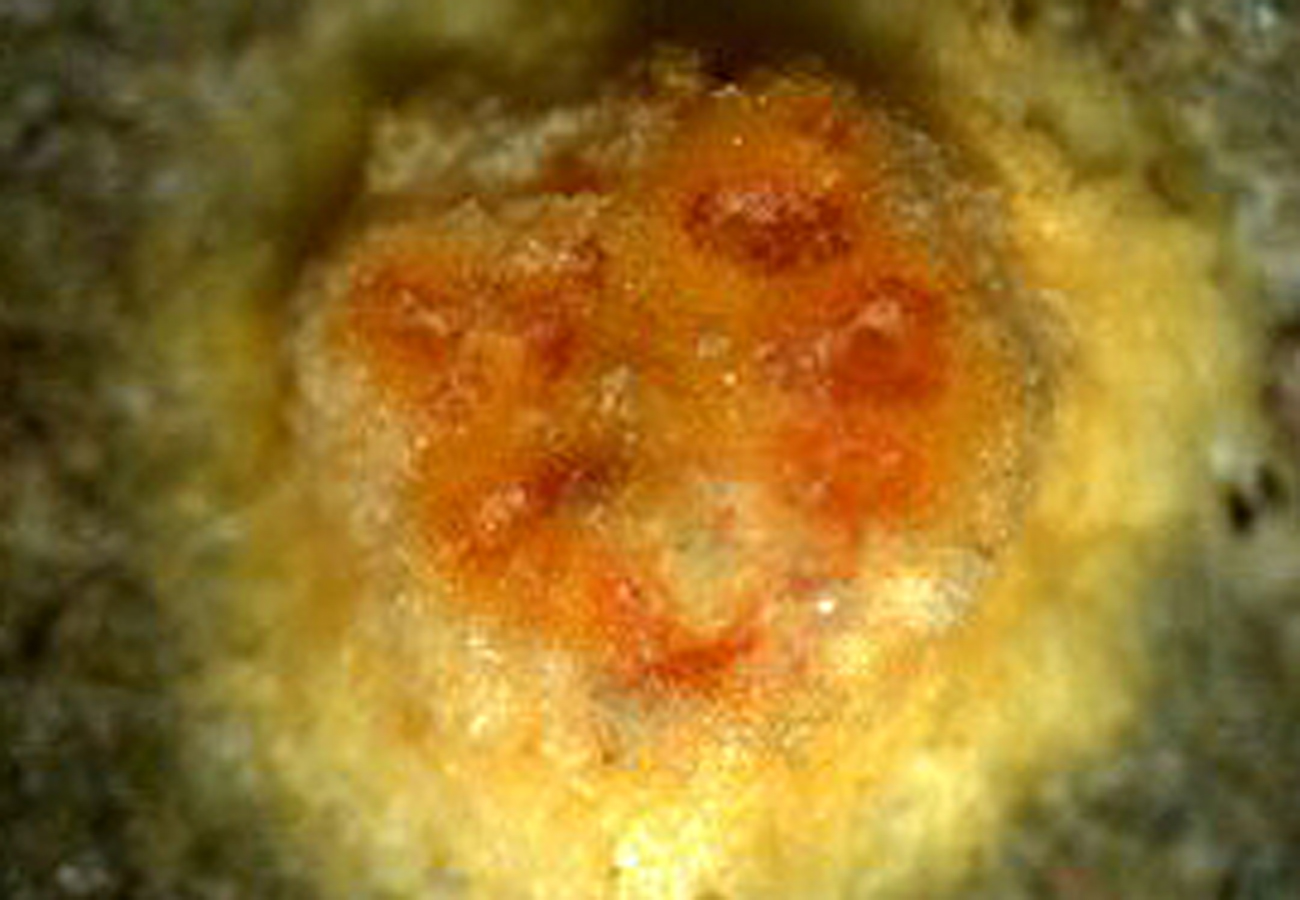Abstract
We report a new species, Moelleriella puerensis, a fungal pathogen infecting scale insect nymphs, from Puer City, Yunnan Province, Southwestern China. Its diagnostic characteristics include pale yellow and thin pulvinate stromata, ovoid tubercles processes developing on the periphery of the stroma, a fully immersed perithecia, orange ostioles, cylindrical asci, and filiform ascospores disarticulated into short secondary spores. Teleomorph and anamorph typically existed in the same stroma, exclusively anamorphic stromata, with pale yellow conidiomata aggregated in the center of the stroma and several conidiomata per stroma fusing with neighboring conidiomata and existing paraphyses. Morphological observations and phylogenetic analyses of combined nrLSU, rpb1, and tef-1α sequence data confirmed the validity of M. puerensis.
References
https://doi.org/10.3852/mycologia.98.5.737
Chaverri, P., Liu, M. & Hodge, K.T. (2008) A monograph of the entomopathogenic genera Hypocrella, Moelleriella, and Samuelsia gen. nov. (Ascomycota, Hypocreales, Clavicipitaceae), and their Aschersonia-like anamorphs in the Neotropics. Studies in Mycology 60: 1–66.
https://dx.doi.org/10.3114/sim.2008.60.01
Chen, Y.X., Xue, Q.L., Xie, Y.X., Keyhani, N.O. & Guan, X. (2020) Moelleriella sinensis sp. nov. (Clavicipitaceae, Ascomycota) from southeast China. Phytotaxa 429: 289–296.
https://dx.doi.org/10.11646/phytotaxa.429.4.5
Darriba, D., Taboada, G.L., Doallo, R. & Posada, D. (2012) jModelTest 2: more models, new heuristics and parallel computing. Nature Methods 9: 772.
https://doi.org/10.1038/nmeth.2109
Evans, H.C. & Hywel-Jones, N. (1990) Aspects of the genera Hypocrella and Aschersonia as pathogens of coccids and whiteflies. In: Vth International Colloquium on Invertebrate Pathology and microbial Control. Society for Invertebrate Pathology, Adelaide, Australia: 111–115.
Meng, L.X., He, X.Y., Wu, Z.W., Qiu, Y.F. & Qiu, J.Z. (2013) A new species of Moelleriella (Clavicipitaceae, Ascomycota) from southwest China. 2013 Asian Mycology Congress and 13th Marine and freshwater Mycology Symposium.
Qiu, J.Z., Chen, Y., Wang, Y.Y. & Guan, X. (2009) The finding of Moelleriella ochracea (Ascomycota, Clavicipitaceae) in China. Mycosystema 28: 148–150.
Hywel-Jones, N.L. & Evans, H.C. (1993) Taxonomy and ecology of Hypocrella discoidea and its anamorph, Aschersonia samoensis. Mycological Research 97: 871–876.
https://doi.org/10.1016/S0953-7562(09)81165-9
Kornerup, A. & Wanscher, J.H. (1978) Handbook of colour. Methuen, London. pp. 1–252.
Larkin, M.A., Blackshields, G., Brown, N.P., Chenna, R., McGettigan, P.A., McWilliam, H., Valentin, F., Wallace, I.M., Wilm, A., Lopez, R., Thompson, J.D., Gibson, T.J. & Higgins, D.G. (2007) Clustal W and Clustal X version 2.0. Bioinformatics 23: 2947–2948.
https://dx.doi.org/10.1093/bioinformatics/btm404
Liu, M. & Hodge, K.T. (2005) Hypocrella zhongdongii sp. nov., the teleomorph of Aschersonia incrassata. Mycological Research 109: 818–824.
https://dx.doi.org/10.1017/S095375620500290X
Liu, Z.Y., Liang, Z.Q., Whalley, A.J.S., Yao, Y.J. & Liu, A.Y. (2001) Cordyceps brittlebankisoides, a new pathogen of grubs and its anamorph, Metarhizium anisopliae var. majus. Journal of Invertebrate Pathology 78: 178–182.
https://doi.org/10.1006/jipa.2001.5039
Liu, M., Chaverri, P. & Hodge, K.T. (2006) A taxonomic revision of the insect biocontrol fungus Aschersonia aleyrodis, its allies with white stromata and their Hypocrella sexual states. Mycological Research 110: 537–554.
https://doi.org/10.1016/j.mycres.2006.01.013
Luangsa-ard, J.J., Tasanathai, K., Mongkolsamrit, S. & Hywel-Jones, N.L. (2007) Atlas of invertebratepathogenic fungi of Thailand. Vol. 1. BIOTEC, NSTDA, Thailand.
Mains, E.B. (1959a) Species of Aschersonia (Sphaeropsidales). Lloydia 22: 215–221.
Mains, E.B. (1959b) Species of Hypocrella. Mycopathologia et Mycologia Applicata 11: 311–326.
Montagne, J.P.F.C. (1848) Sixième centurie de plantes cellulaires exotiques nouvelles. Cryptogamae Taitenses. Annales des Sciences Naturelles Botanique, Série 3, 10: 106–136.
Rehner, S.A. & Samuels, G.J. (1994) Taxonomy and phylogeny of Gliocladium analysed from nuclear large subunit ribosomal DNA sequences. Mycological Research 98: 625–634.
https://doi.org/10.1016/S0953-7562(09)80409-7
Ronquist, F. & Huelsenbeck, J.P. (2003) MrBayes 3: Bayesian phylogenetic inference under mixed models. Bioinformatics 19: 1572–1574.
httpa://dx.doi.org/10.1093/bioinformatics/btg180
Stamatakis, A., Hoover, P. & Rougemont, J. (2008) A rapid bootstrap algorithm for the RAxML Web servers. Systematic Biology 57: 758–771.
https://dx.doi.org/10.1080/10635150802429642
Sung, G.H., Hywel-Jones, N.L., Sung, J.M., Luangsa-Ard, J.J., Shrestha, B. & Spatafora, J.W. (2007) Phylogenetic classifcation of Cordyceps and the clavicipitaceous fungi. Studies in Mycololgy 57: 5–59.
https://doi.org/10.3114/sim.2007.57.01
Petch, T. (1921) Studies in entomogenous fungi. II. The genera of Hypocrella and Aschersonia. Annals of the Royal Botanic Gardens Peradeniya 7: 167–278.
Qiu, J.Z., Ma, H.F., Wang, Y.Y. & Guan, X. (2009) Two Aschersonia species from Fujian new to China. Mycosystema 28: 60–63.
Tamura, K., Stecher, G., Peterson, D., Filipski, A. & Kumar, S. (2013) MEGA6: Molecular Evolutionary Genetics Analysis Version 6.0. Molecular Biology and Evolution 30: 2725–2729.
https://dx.doi.org/10.1093/molbev/mst197
Tzean, S.S., Hsieh, L.S. & Wu, W.J. (1997) Atlas of Entomopathogenic Fungi. Council of Agriculture. Executive Yuan, Taiwan.
Vilgalys, R. & Hester, M. (1990) Rapid genetic identifcation and mapping of enzymatically amplifed ribosomal DNA from several Cryptococcus species. Journal of Bacteriology 172: 4238–4246.
https://doi.org/10.1128/jb.172.8.4238-4246.1990
Wang, Y.B., Yu, H., Dai, Y.D., Wu, C.K., Zeng, W.B., Yuan, F. & Liang, Z.Q. (2015) Polycephalomyces agaricus, a new hyperparasite of Ophiocordyceps sp. infecting melolonthid larvae in southwestern China. Mycological Progress 14: 70.
https://dx.doi.org/10.1007/s11557-015-1090-7
Wang, Y.B., Wang, Y., Fan, Q., Duan, D.E., Zhang, G.D., Dai, R.Q., Dai, Y.D., Zeng, W.B., Chen, Z.H., Li, D.D., Tang, D.X., Xu, Z.H., Sun, T., Nguyen, T.T., Tran, N.L., Dao, V.M., Zhang, C.M., Huang, L.D., Liu, Y.J., Zhang, X.M., Yang, D.R., Sanjuan, T., Liu, X.Z., Yang, Z.L. & Yu, H. (2020) Multigene phylogeny of the family Cordycipitaceae (Hypocreales): new taxa and the new systematic position of the Chinese cordycipitoid fungus Paecilomyces hepiali. Fungal Diversity 103: 1–46.
https://doi.org/10.1007/s13225-020-00457-3


